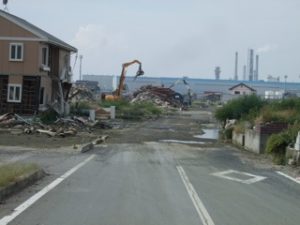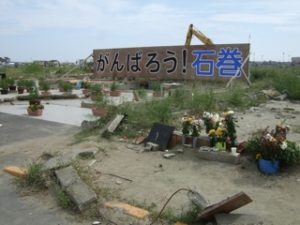Ishinomaki September 2011
- At July 26, 2016
- By anneblog
- In Annes Letters
 0
0
September 18, 2011
Dear Family and Friends,
Recently a friend visited me. At the end of his stay, I escorted him to Narita Airport to see him off. It was very eerie there with a paucity of travelers. Only a few passengers were wandering about, and very few of them were westerners. Even so, the staff members politely maintained their routine behaviors of bowing and giving assistance when needed. Ueno Station in Tokyo, usually a bubbling hub, was also strangely quiet. That was because business hours are now staggered to put less of a strain on energy usage during peak hours. And all businessmen wear short sleeved shirts with no jackets or ties. The trip back home up the coast revealed city after city with dimmed lights, making it feel as if the country were experiencing war. But none of that was due to armed conflict, but rather to energy conservation measures now that nuclear power is in question. I was impressed that everyone without protest was complying with the government’s request to cut back on energy consumption.
“Japan is in a cycle of great purification,” shaman mediums are saying about this time of terrible challenge. “Purging by water, by fire, by destruction, by testing people’s character and strength to endure.” And from the earthquakes and tsunami damage in the north to the typhoons and mudslides in the south that does indeed seem to be the case.
Even though six months have passed since the Great Northeast Earthquake and Tsunami, and even though the center of Sendai is more or less back to normal working order, and even though ongoing work to clear away rubble is continuing where needed, there remain whole areas that are still in shatters and thousands of people still eking out a living in evacuation centers or in vehicles.
Recently two friends and I went to Ishinomaki and the Onnagawa Peninsula in northern Miyagi Prefecture. We wanted to see what progress had been made there in the past few months. And also even though our own lives have slowly been stabilizing, we want to keep our hearts open to what is happening in areas less fortunate than ours.
When we arrived, much of Ishinomaki seemed completely normal. Shops were open and seemed to be doing well. Private homes were tidy and had trim gardens full of flowers. But even so, there were no functioning traffic signals and a few buildings had enormous cracks, shattered windows, or collapsed roofs.
As we approached the sea, however, everything began to change. There were large areas of vacant space where whole neighborhoods had once stood. Pocked marked through that emptiness were the skeletons of a few homes, some almost completely ruined, others with walls still in tact, but with windows smashed and curtains blowing in the breeze.

One house had a pile of dishes in a doorway, another books — just in case someone might be alive, someone might come back in an attempt to connect to their roots and to the life that once was.

The tsunami’s path was well marked. It was wide and deep. It began by hitting a hospital, which even now has splintered glass, misplaced and fallen furniture, a bus stop sign and benches, but no one anywhere nearby at all.

There was a lopsided pharmacy and lurching nursing home standing in water next door.

And further back an entire elementary school clearly revealed the tsunami’s rage had pounded well up to the third floor, even to the fourth. The building was hollow, empty, and echoing. Cries of terror and focused attention for escape haunted everywhere. It was agonizing to witness with wide open hearts what lay in tatters before us.
The areas affected by this monstrous sea dragon’s fury were still in the process of being cleared up. The Japanese Army had just left after six months of hard work. And the Red Cross had departed a bit earlier. The billions of yen donated domestically and internationally for relief efforts are being divided out to each affected area. But the ongoing labors are now the responsibility of local governments.
We watched compact backhoes and small cranes pick up one rock, one board, or one brick at a time. Then they put this single item down in another spot.

Trucks picked these up and then went to rubbish dumps, which soared above like huge mountains. These vehicles plied back and forth non-stop all day.

As one friend pointed out, the work was being done in stages. First was to clear out a pathway to build a few access roads. Second, which is still happening, is to clear out the rubble. Once that is more or less completed, decisions can be made concerning the few abandoned buildings: fishing warehouses, homes, apartments, small businesses, schools, and a hospital. Much later will come city planning, creating a new and happier face to that area. But what is to be done with the privately owned property? Will there be homes again? Businesses? Or maybe parks? Will people dare to establish there lives so near the sea once again?
A few of the homes a bit further back from the sea were left standing. They had obliterated first floors, but miraculously had second floors intact enough for people to astonishingly eek out a precarious living in them. We saw newly washed laundry flapping on balconies, futons airing out of windows, and kids’ play pools filled with much needed water in yards. Seeing bent electric poles and tangled wires everywhere, we presumed there was no electricity or running water available for those homes.

Although many people are still in evacuation centers, we did see rows and rows of temporary housing. Those metal abodes were basic, but nice. They had a kitchen, a bathroom, a living room, and a bedroom. Everything inside was very compact. These buildings were all very close together due to lack of space, but that provided a sense of community and of moral support. Unfortunately, there are very few jobs these days, and loans are difficult to come by. So even now in some places food is still being delivered daily to people in those temporary homes.
There was an altar arranged right in the center of the large cleared out area. It was humble, with a few flowers in jars and small metal boxes for incense. There was also a large sign saying, “Gambaro Ishinomaki.” One friend had thought to bring incense, which we lit and then we bowed low to pray.

So much of what is happening here now is on levels far deeper than what the eye can witness or even what the mind can comprehend or the heart can fathom. So we pray. We hope. And then we return to the world to help in whatever ways call us.
Near the altar there was a man standing next to his car. He called out to me, “Hey you! Come over here. Look. That metal frame of a building over there used to be my noodle shop. I worked there for over forty years. We had a booming business, the best noodles in town. Look! Look! Here are the photos of the tsunami devouring my place. Here’s my wife’s car. I haven’t located her even now. I am so lonely. But I want to start again, have a shop, sell noodles. But I have no money. I must dream on the level of possibilities. So I am hoping to get a truck. I will turn it into a mobile restaurant and sell noodles from it. I’m still looking for my wife. I am alone now. But I want to work again. I need to work again. See. Look. I have a T-shirt with my face on it. I have a drawing of me making noodles. I went down south to a benefit festival and cooked up a storm. Here’s a poster of it. I want to get back to being able to work like I did before. I’m selling magazines with photos of this city just as the tsunami hit. When that happened, I lost everything but my life. This is a very difficult time, but I have dreams. I want to work again. I am trying so hard.”

Of course, my friends and I bought the magazine, filled with heart-wrenching images of that tragedy. And of course, we stayed and listened as he talked on and on. Then others came and he started his story all over again. They, too, kindly listened, bought his magazine, and stayed on as we finally left.
We picked up a young volunteer and took him to the station. Trains are not running, but buses are. “I come from Kyoto,” he said. “I took a week off from work to volunteer up here. I lived through the Hanshin Earthquake in 1995. My grandparents lost their home in that. I was little then and couldn’t do much. But it showed me how much people suffer in times like these. So I really had to come up here to do something. But I’m floored by how much work still needs to be done. Six months after the Hanshin Quake things were pretty much back to normal. We did not have a tsunami, though. And that makes a huge difference. It is going to take years and years to get this place fixed up. I just can’t believe what damage that tsunami did.”
However, we saw working fishing and shrimp boats bobbing in the water. Many wharves are now open for them to dock.

Shopkeepers from one section of the destroyed areas banded together and opened a teeny Ginza of restaurants. And clean up work never stops. Of course, a great deal still needs to be done. Yet it is important to see how much already has been done. And against all odds the tenacious Japanese spirit is indeed holding on. People all over the country are united in pulling this nation back up. Each individual’s efforts may be small: cutting back on energy use, dropping a few coins in a collection box, or volunteering for a few days. But everyone holds on to the unquestioned belief that together we will get back on our feet and make tomorrow better.
Love,
Anne



